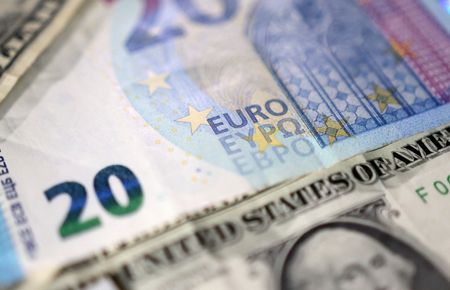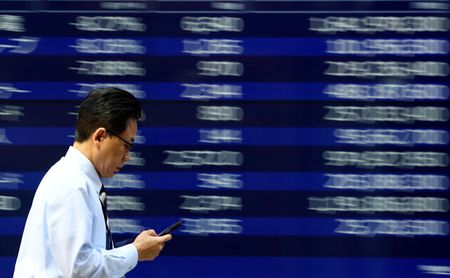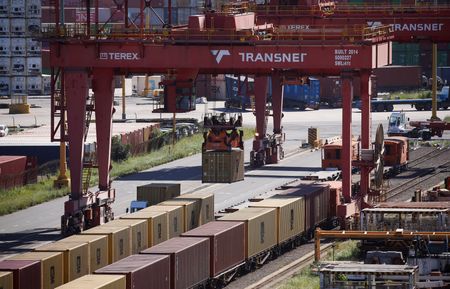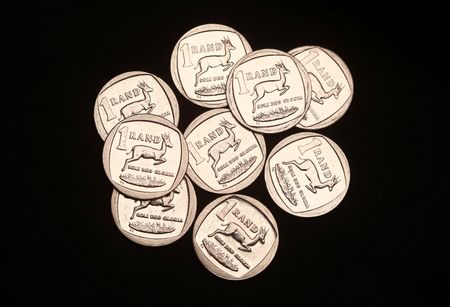By Alun John, Yoruk Bahceli and Nell Mackenzie
LONDON (Reuters) – Euro bulls are facing the first big test of their conviction in the form of the European Union’s U.S. trade deal, which has cast doubt on the durability of one of 2025’s most popular trades.
The euro, which hit a four-year high of $1.1830 earlier this month, on Tuesday was last at $1.1522, headed for its biggest two-day drop in nearly three years, after the EU agreed to a 15% tariff on its U.S. exports – half the rate President Donald Trump had previously threatened, but well above the roughly 1.5-2% rate prior to his return to the White House.
That’s quite a reversal. The euro’s 14% gain in the first half of the year was the biggest since its creation, as investors rushed to the common currency on the back of the announcement of a once-in-a-generation shift in German fiscal spending just as U.S. President Donald Trump’s erratic trade policies drove flows out of U.S. assets.
But both of those factors are challenged by the agreement: The European economy will still take a hit from the tariffs, while deals the U.S. has agreed with the EU and other partners have reduced fears about a major slowdown there.
“The long euro trade is undoubtedly facing a reality check this week,” said Bruno Schneller, managing director at Erlen Capital Management.
“Monday’s sharp drop in euro/dollar felt like more than just a reaction to headlines — it exposed how stretched positioning had become in one of the market’s most consensus views.”
“What stood out wasn’t just the magnitude of the move, but the lack of support on the way down.”
Going into the weekend, speculators were sitting on a bullish bet on euro futures worth $18.4 billion, the largest since December 2023, according to weekly data from the Commodity Futures Trading Commission.
That position has been building since last December. At the start of the year speculators held one of their largest bearish positions in the euro in almost five years.
RELATIVE ECONOMIC PERFORMANCE
The euro also weakened sharply against other currencies on Monday, dropping 0.8% on the pound and 0.7% on the Japanese yen, again after recent gains.
But the bulk of its moves, both up this year, and down this week, have been against the dollar. In trade-weighted terms, the euro is only up about 6% this year.
And its gains on the U.S. currency were already slowing as initial pessimism towards the U.S. at the start of the year faded thanks to strong economic data and earnings, reinforced by the flurry of trade deals with Japan and the EU, and ongoing negotiations with China.
“The (U.S.-EU) trade deal has removed a potential headwind (for the euro) but it has also removed an uncertainty for the dollar too, which leaves the euro looking a little overvalued,” said Michael Metcalfe, head of macro strategy at State Street.
But the end of the euro’s rally on the dollar is not yet a done deal.
“The vast majority of people – ourselves included – think that this is just a correction to an underlying bull trend in euro/dollar,” said Chris Turner, global head of research at ING.
He said the biggest test would be on the dollar side of the currency pair, as investors had now digested the impact of the trade deal on Europe.
Therefore, the focus turns to this week’s economic data, including U.S. jobs and inflation and European economic growth, and Wednesday’s Federal Reserve meeting.
The Fed is likely to keep U.S. interest rates steady, which may generate more angry rhetoric from Trump who has been pushing for big cuts.
This matters for the dollar. The currency fell sharply earlier this month, including against the euro, when Trump appeared close to trying to fire Fed Chair Jerome Powell.
And even setting aside the trade deal, there are reasons to be optimistic about Europe, particularly given Germany’s spending plans.
“We haven’t changed our view of upside risks to growth in Europe,” said Russel Matthews, portfolio manager at RBC BlueBay Asset Management, who has been neutral on currencies as he balanced “the long term structural bias for a weakening dollar” with “the more positive short-term technical picture.”
“The new narrative that the U.S. has got a better deal has tarnished, to some extent, the upside potential from developments in the last three to six months in Europe, but it hasn’t necessarily changed that dynamic.”
(Reporting by Alun John, Nell Mackenzie and Yoruk Bahceli in London, additional reporting by Lucy Raitano, editing by Amanda Cooper and Hugh Lawson)









